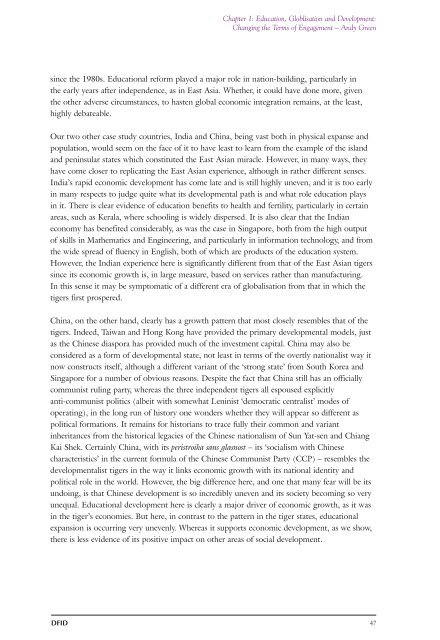education-dev-global-era-69
education-dev-global-era-69
education-dev-global-era-69
You also want an ePaper? Increase the reach of your titles
YUMPU automatically turns print PDFs into web optimized ePapers that Google loves.
Chapter 1: Education, Globlisation and Development:Changing the Terms of Engagement – Andy Greensince the 1980s. Educational reform played a major role in nation-building, particularly inthe early years after independence, as in East Asia. Whether, it could have done more, giventhe other adverse circumstances, to hasten <strong>global</strong> economic integration remains, at the least,highly debateable.Our two other case study countries, India and China, being vast both in physical expanse andpopulation, would seem on the face of it to have least to learn from the example of the islandand peninsular states which constituted the East Asian miracle. However, in many ways, theyhave come closer to replicating the East Asian experience, although in rather different senses.India’s rapid economic <strong>dev</strong>elopment has come late and is still highly uneven, and it is too earlyin many respects to judge quite what its <strong>dev</strong>elopmental path is and what role <strong>education</strong> playsin it. There is clear evidence of <strong>education</strong> benefits to health and fertility, particularly in certainareas, such as K<strong>era</strong>la, where schooling is widely dispersed. It is also clear that the Indianeconomy has benefited consid<strong>era</strong>bly, as was the case in Singapore, both from the high outputof skills in Mathematics and Engineering, and particularly in information technology, and fromthe wide spread of fluency in English, both of which are products of the <strong>education</strong> system.However, the Indian experience here is significantly different from that of the East Asian tigerssince its economic growth is, in large measure, based on services rather than manufacturing.In this sense it may be symptomatic of a different <strong>era</strong> of <strong>global</strong>isation from that in which thetigers first prospered.China, on the other hand, clearly has a growth pattern that most closely resembles that of thetigers. Indeed, Taiwan and Hong Kong have provided the primary <strong>dev</strong>elopmental models, justas the Chinese diaspora has provided much of the investment capital. China may also beconsidered as a form of <strong>dev</strong>elopmental state, not least in terms of the overtly nationalist way itnow constructs itself, although a different variant of the ‘strong state’ from South Korea andSingapore for a number of obvious reasons. Despite the fact that China still has an officiallycommunist ruling party, whereas the three independent tigers all espoused explicitlyanti-communist politics (albeit with somewhat Leninist ‘democratic centralist’ modes ofop<strong>era</strong>ting), in the long run of history one wonders whether they will appear so different aspolitical formations. It remains for historians to trace fully their common and variantinheritances from the historical legacies of the Chinese nationalism of Sun Yat-sen and ChiangKai Shek. Certainly China, with its peristroika sans glasnost – its ‘socialism with Chinesecharacteristics’ in the current formula of the Chinese Communist Party (CCP) – resembles the<strong>dev</strong>elopmentalist tigers in the way it links economic growth with its national identity andpolitical role in the world. However, the big difference here, and one that many fear will be itsundoing, is that Chinese <strong>dev</strong>elopment is so incredibly uneven and its society becoming so veryunequal. Educational <strong>dev</strong>elopment here is clearly a major driver of economic growth, as it wasin the tiger’s economies. But here, in contrast to the pattern in the tiger states, <strong>education</strong>alexpansion is occurring very unevenly. Whereas it supports economic <strong>dev</strong>elopment, as we show,there is less evidence of its positive impact on other areas of social <strong>dev</strong>elopment.DFID 47





